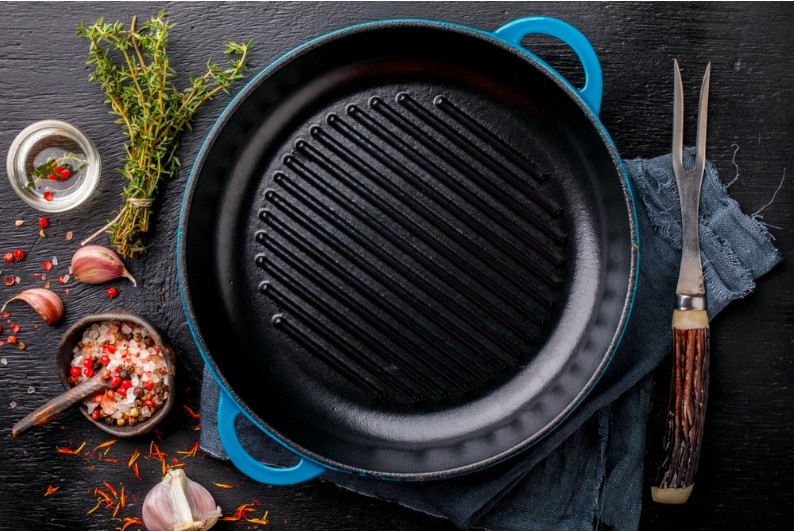How To Season Cast Iron Cookware To Cook Evenly & Fast

When it comes to cast iron cookware, the term seasoning is fundamental but often misunderstood. Seasoning your cast iron doesn’t involve herbs and spices; instead, it refers to a process that enhances your pan’s performance and longevity. Understanding how to season cast iron is crucial for anyone looking to make the most out of these durable kitchen tools.
The importance of properly seasoning cast iron cannot be overstated. This essential step is what transforms your new or restored skillet into a non-stick cooking surface, making it perfect for everything from searing steaks to baking cornbread. Moreover, a well-maintained season layer not only prevents food from sticking but also protects the pan from rust and wear.
Benefits of a well-seasoned cast iron pan include a naturally non-stick surface that improves with each use and excellent heat retention. By learning how to season cast iron pan, you ensure that your cookware reaches its full potential, providing delicious results and enduring through generations of cooking adventures.
1 What You Need to Season Cast Iron?
Before diving into the seasoning process, it’s essential to gather the necessary materials. Here’s a list of items you’ll need:
- Mild Soap: Choose a gentle dish soap to clean your cast iron without stripping away its seasoned layer.
- Scrubbing Brush: Opt for a stiff-bristled brush or sponge to remove any stubborn food particles without damaging the pan’s surface.
- Clean Towels: Have a stack of clean, dry towels ready for drying your cast iron thoroughly.
- Cooking Oil: Selecting the right oil is crucial for achieving a perfect seasoning. Common options include vegetable oil, canola oil, flaxseed oil, and grapeseed oil.
- Oven Mitts: Protect your hands from the heat of the oven with a pair of oven mitts or heat-resistant gloves.
When it comes to choosing the best oil for seasoning, each type has its unique benefits:
- Vegetable Oil: Widely available and affordable, vegetable oil forms a durable seasoning layer with regular use.
- Canola Oil: With its neutral flavour and high smoke point, canola oil is a popular choice for seasoning cast iron.
- Flaxseed Oil: Known for its ability to polymerize into a hard, slick coating, flaxseed oil creates a superior non-stick surface ideal for delicate foods like eggs and pancakes.
- Grapeseed Oil: Similar to canola oil, grapeseed oil boasts a high smoke point and neutral taste, making it suitable for seasoning cast iron at high temperatures.
Experimenting with different oils can help you find the perfect seasoning method for your cast iron cookware. Remember to always apply a thin, even layer of oil to your pan before seasoning to ensure consistent results.
2 Preparing Your Cast Iron for Seasoning
Before you can begin the seasoning process, it’s crucial to properly prepare your cast iron cookware. This preparation ensures that your seasoning adheres well and lasts longer. Follow these step-by-step instructions to get your cast iron ready for seasoning:
Washing with Soap and Water

Start by washing your pan with mild soap and warm water. This step is essential to remove any residues or contaminants that might have built up during storage or cooking. Use a scrubbing brush to gently clean the surface without scratching the metal.
Drying Thoroughly to Prevent Rust
After washing, dry your cast iron thoroughly with a clean towel or cloth. Cast iron is prone to rust when left wet, so ensure no moisture remains. For extra assurance, you can place the cookware on a stove over low heat to evaporate any residual moisture.
Tips on Removing Rust If Already Present

- Create a Cleaning Paste: Combine salt with enough cooking oil to form a paste. The salt acts as an abrasive that will help scrub off the rust, while the oil helps to lubricate the surface, minimising further damage during the cleaning process.
- Use a Potato as a Scrubber: Cut a potato in half and dip the cut side into the salt and oil paste. Potatoes contain oxalic acid, which is effective in breaking down rust. The starchy texture of the potato also helps in holding the paste and transferring it effectively onto the rusted areas.
- Scrub the Affected Area: Using the potato half as a brush, scrub the paste over the rusted parts of your cast iron cookware. Apply some pressure to help the abrasive particles in the salt scrape away the rust.
- Rinse and Dry Thoroughly: Once you’ve scrubbed the rust away, rinse your cookware thoroughly under warm water to remove all traces of salt and oil. Immediately dry the pan completely with a clean towel or heat it on the stove to evaporate any remaining moisture. This step is crucial to prevent new rust from forming.
- Season the Pan: After removing the rust and drying your cast iron, it’s important to season it to restore its non-stick surface and protect it from future rusting. Apply a thin coat of oil and heat as per the seasoning instructions.
3 The Cast Iron Seasoning Process
Seasoning your cast iron cookware is a simple but essential process to create a non-stick surface and prevent rust. Here’s how you can season your cast iron effectively:
- Preheat the Oven: Start by preheating your oven to 375 degrees Fahrenheit (190 degrees Celsius). This temperature is high enough to allow the oil to polymerize and form a protective layer over the cast iron.
- Apply a Thin Coat of Oil: Take a clean cloth or paper towel and lightly dab it into your chosen seasoning oil (as discussed, vegetable oil, canola oil, flaxseed oil, or grapeseed oil are great options). Wipe the oil over the entire surface of the cookware, including the outside and handle. Ensure the coat is thin to avoid a sticky residue after baking.
- Place the Cookware Upside Down in the Oven: Place your cast iron cookware upside down in the preheated oven. This positioning prevents oil from pooling in the bottom of the pan, which can lead to uneven seasoning. You can place a sheet of aluminium foil or a baking sheet on the lower rack to catch any drips.
- Bake at a High Temperature: Bake the cast iron in the oven for one hour. This duration allows the oil to break down and bond with the iron, creating a hard, protective layer.
- Cooling Process: After the hour is up, turn off the oven and let the cast iron cool down inside until it reaches room temperature. Cooling in the oven helps the seasoning to set better and ensures the cast iron does not undergo sudden temperature changes, which might cause warping.
- Repeat if Necessary: For even better results, you might want to repeat the oiling and baking steps a few times. Multiple layers of seasoning can further enhance the non-stick quality and durability of your cookware.

4 After Seasoning Care
Maintaining your cast iron cookware after the seasoning process is crucial for ensuring its longevity and performance. Here are detailed steps on how to cool, store, and care for your cast iron post-seasoning:
How to Cool and Store Your Cookware Post-Seasoning
- Cooling: After the seasoning process, turn off the oven and leave the cast iron inside with the door slightly ajar. This allows the cookware to cool down gradually, preventing thermal shock, which could warp or damage the metal.
- Storage: Once completely cooled, store your cast iron in a dry, airy space. Avoid stacking other pots or pans on top of the seasoned surface to prevent scratches or other damage. If you must stack your cookware due to space constraints, place a layer of paper towel or cloth between each piece to protect the seasoning.
Tips for Maintaining the Seasoning After Each Use
- Cooking Practices: Use a small amount of oil or fat every time you cook. This practice not only prevents sticking but also continuously fortifies the seasoning layer.
- Post-Cooking: Allow the pan to cool to a safe handling temperature before cleaning. This prevents the metal from experiencing sudden temperature changes that can harm the seasoning.
Cleaning Methods Post-Use to Maintain the Seasoned Coating
- Immediate Cleaning: After cooking, while the pan is still warm, use a spatula or scraper to remove any stuck-on food. This is easier when the pan is warm as residues are less likely to have hardened.
- Rinsing and Drying: Rinse the cookware with hot water, using a brush or sponge to gently clean the surface. Avoid using soap as it can strip away the seasoning. After rinsing, dry the pan thoroughly using a towel or by heating it on a stove burner for a few minutes to evaporate any remaining moisture.
- Oil Application: Once dry, apply a thin layer of cooking oil to the surface. Use a paper towel to wipe the oil across the cooking area and exterior. This light coating protects the seasoning from moisture and keeps the surface non-stick.

5 Common Seasoning Mistakes and How to Avoid Them
Seasoning cast iron cookware is a straightforward process, but common errors can affect the quality and longevity of the seasoning. Here are some frequent mistakes and how to correct them to ensure successful seasoning:
Using Too Much Oil
Problem: Applying too much oil can lead to a sticky or tacky finish on the cookware because the excess oil doesn’t polymerize properly and instead pools on the surface.
Solution: Always use a clean cloth or paper towel to wipe the oil around the entire surface of the pan, including the exterior and handle. Ensure that you apply a very thin layer. After coating, wipe off the excess oil thoroughly until the pan looks almost dry.
Not Heating Long Enough
- Problem: Insufficient heating during the seasoning process can prevent the oil from reaching the polymerization point, leading to an ineffective seasoning layer that doesn’t properly protect the pan.
- Solution: Bake the cast iron in the oven for at least an hour at 375°F (190°C). This duration and temperature allow the oil to fully break down and bond with the surface of the cookware. Make sure your oven is preheated before placing the pan inside.
Using the Wrong Type of Oil
- Problem: Some oils have lower smoke points, which can burn off too quickly during the seasoning process, failing to create a durable layer.
- Solution: Choose oils with a high smoke point, such as flaxseed oil, canola oil, or grapeseed oil. These oils can withstand the high temperatures required for effective seasoning without breaking down prematurely.
Skipping Oven Preheating
- Problem: Placing the cookware in an oven that is not fully preheated can lead to uneven heating and poor seasoning results.
- Solution: Always preheat your oven to the required temperature before placing your cast iron inside. This ensures that the entire surface of the pan is evenly exposed to the heat, facilitating a uniform seasoning layer.
Inadequate Post-Seasoning Care
- Problem: Failing to maintain the seasoning after initial application can lead to deterioration of the non-stick surface and rust formation.
- Solution: After each use, clean the pan with hot water and a brush, dry it thoroughly, and apply a light layer of oil before storing. This routine helps maintain the seasoning and protects the pan from moisture.
6 Wrapping Up
Seasoning your cast iron cookware is not just a routine maintenance task; it’s an essential process that enhances the durability, functionality, and overall cooking performance of your pans. Proper seasoning creates a non-stick surface, prevents rust, and gradually builds a cooking surface that improves with age and use. By following the step-by-step guide and avoiding common mistakes, you can ensure that your cast iron becomes a treasured kitchen staple, capable of cooking flawless dishes for years to come.
We encourage you to follow these steps closely to achieve optimal results with your cast iron. Each piece of cookware can become better over time if properly maintained, turning every meal into a beautifully cooked masterpiece. Remember, the effort you put into seasoning and caring for your cast iron pays off with superior cooking experiences.
We’d love to hear from you! Share your tips and experiences with seasoning cast iron cookware in the comments below. Whether you’re a seasoned chef or a home cook, your insights can help others perfect their technique and enjoy the many benefits of well-maintained cast iron.
FAQ's about How To Season Cast Iron Cookware
What is the best way to season cast iron?
The best way to season cast iron involves cleaning the skillet thoroughly first, making sure it’s free from any residue or rust. Wash it with warm, soapy water and a stiff brush, and then dry it completely to prevent rusting. Next, coat the entire skillet, including the inside, outside, and handle, with a thin layer of high-smoke point oil such as flaxseed, canola, or grapeseed oil. These oils are ideal because they polymerize well, forming a strong seasoning layer.
After oiling, it’s important to wipe off any excess to prevent the surface from becoming sticky; you want just a very thin coat remaining. Place the skillet upside down in a preheated oven set to around 375-400°F (190-204°C) and place a sheet of aluminum foil or a baking sheet on the lower rack to catch drips. Bake the skillet for one hour to allow the oil to polymerize properly and form a hardened layer.
Once baked, let the skillet cool inside the oven until it reaches room temperature; this gradual cooling helps prevent the seasoning from cracking. For an even more robust seasoning, you may want to repeat the oiling and baking process a few times. Regularly seasoning your cast iron skillet in this way will enhance its non-stick properties and durability, ensuring it performs well for many years of cooking.
What is the best oil to season cast iron with?
The best oil to season cast iron is one that has a high smoke point and the ability to polymerize effectively to form a hard, durable layer. Flaxseed oil is often considered the ideal choice for seasoning cast iron due to its high content of alpha-linolenic acid, which allows it to polymerize faster and create a strong, slick surface.
However, because flaxseed oil can be a bit pricey and prone to flaking if not applied correctly, many people also recommend using canola oil, grapeseed oil, or even refined avocado oil. These oils also have high smoke points, making them good choices for creating a non-stick surface that lasts. Canola oil, in particular, is a popular choice because it’s affordable, widely available, and effective at forming a durable seasoning layer.
How many times can you season a cast iron pan?
You can season a cast iron pan multiple times, and doing so can be beneficial, especially when you’re first establishing a seasoning layer or restoring an old or neglected pan. Typically, seasoning a cast iron pan 3-4 times initially helps to create a strong, durable non-stick surface. Each layer of seasoning builds upon the previous one, enhancing the pan’s performance.
After the initial seasoning, you might not need to season the pan as frequently. Regular maintenance seasoning is recommended when you notice food starting to stick more than usual, or after cleaning off rust. This maintenance might only be necessary a few times a year depending on how often you use and clean the pan. Regular cooking with fats and oils can also help maintain and even improve the seasoning over time. Thus, there is no strict limit to how many times you can season a cast iron pan; it largely depends on your usage and care practices.
How do you know when cast iron is seasoned?
The surface of a well-seasoned cast iron pan will appear smooth and semi-glossy with a uniform dark, almost black satin finish. This appearance indicates that the seasoning has polymerized correctly and formed a protective layer.
Another way to assess the seasoning is by testing its non-stick performance. If the pan is well-seasoned, foods like eggs or pancakes should slide off with minimal sticking, suggesting a good seasoning. Additionally, you can perform a simple water test: sprinkle a few drops of water onto the skillet. In a well-seasoned pan, the water should bead up and either slide around or dance on the surface rather than sitting flat and starting to boil or stick.
Lastly, the touch of the pan can also tell you about its seasoning state. The surface should feel smooth to the touch and not sticky or tacky. If it feels sticky, this could be due to excess oil that hasn’t been fully polymerized during seasoning, and the pan may need to be seasoned again at a higher temperature or for a longer time.
Can I use ghee to season cast iron?
Yes, you can use ghee to season cast iron. Ghee, or clarified butter, is a popular choice for seasoning because it has a high smoke point, which is important for the seasoning process. During the clarification process, the milk solids and water are removed from butter, leaving behind pure butterfat. This allows ghee to withstand higher cooking temperatures without burning, making it effective for creating a durable and non-stick seasoning layer on cast iron surfaces.
To season your cast iron with ghee, ensure that your pan is clean and completely dry. Apply a thin layer of ghee to the entire surface of the pan, including the outside and handle. Wipe off any excess to avoid a sticky residue. Place the pan upside down in an oven preheated to around 400 degrees Fahrenheit (about 204 degrees Celsius) and bake for an hour. Allow the pan to cool in the oven. This process can be repeated a few times to build up a strong seasoning layer.
Ghee’s high smoke point and absence of milk solids make it a suitable and sometimes preferred alternative to other oils traditionally used for seasoning cast iron.
Can I use coconut oil to season cast iron?
Yes, you can use coconut oil to season cast iron, although it might not always be the first choice compared to oils with higher smoke points. Coconut oil has a relatively high smoke point (around 350°F for unrefined and 400°F for refined), making it feasible for seasoning cast iron. However, its lower smoke point compared to options like flaxseed oil or canola oil means it may not polymerize as effectively, which is essential for forming a durable seasoning layer.
If you choose to use coconut oil, it’s best to use refined coconut oil because it has a higher smoke point and is less prone to burning.
Community Q&A
About This Article
This article has been viewed 768 times.



